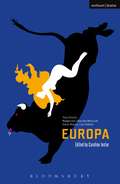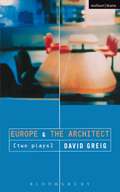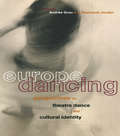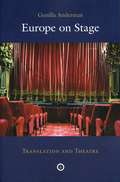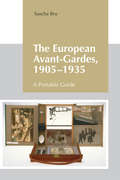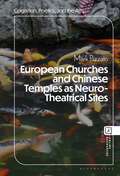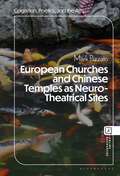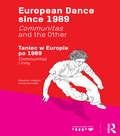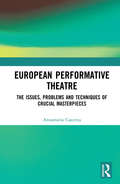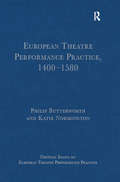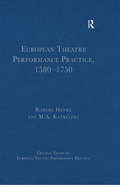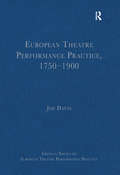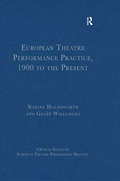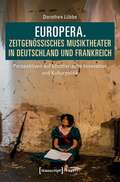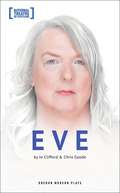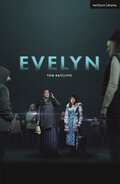- Table View
- List View
Europa (Modern Plays)
by Lutz Hübner Malgorzata Sikorska-Miszczuk Tena Štivicic Steve Waters Caroline JesterEuropa brings together four European theatres: Birmingham Repertory Theatre (UK), Dresden State Theatre (Germany), Teatr Polski Bydgoszcz (Poland) and Zagreb Youth Theatre (Croatia) – and four leading playwrights from each country – Steve Waters (UK), Lutz Hübner (Germany), Malgorzata Sikorska-Miszczuk (Poland) and Tena Štivicic (Croatia). This revelatory piece of theatre sets out to explore the possibilities of collaborative playwriting, to produce a single work that is multi-authored and multi-lingual. Drawing on first-hand accounts, including memories from the 1930s up to the present day, the playwrights have collaborated to overcome language barriers and weave their separate languages into one single dramatic entity. The resulting play engages with increased levels of debate about European identity versus national identity. This edition features both the multi-lingual and the English text, and has an introduction by the dramaturg behind the project, Caroline Jester.
'Europe' & 'The Architect' (Modern Plays)
by David Greig"The most important playwright to have emerged north of the border in years." (Scotsman)Europe is set in a railway station at an unnamed border town where old and new Europeans weave a tale of love, loss and longing. "Fierce, compassionate, mightily ambitious drama...There is the sharp, analytic intelligence, the crackling inventiveness of a real writer buzzing about this gripping play." (The Scotsman)The Architect charts the rise and fall of Leo Black, once an idealistic and idolised designer, whose magnificent visions are now crumbling, along with his family, in the light of grubby reality. "Provides convincing evidence of David Greig's confident transition from a dramatist of promise to one of stature." (Indpendent)
'Europe' & 'The Architect': Europe; The Architect; The Cosmonaut's Last Message... (Modern Plays)
by David Greig"The most important playwright to have emerged north of the border in years." (Scotsman)Europe is set in a railway station at an unnamed border town where old and new Europeans weave a tale of love, loss and longing. "Fierce, compassionate, mightily ambitious drama...There is the sharp, analytic intelligence, the crackling inventiveness of a real writer buzzing about this gripping play." (Scotsman)The Architect charts the rise and fall of Leo Black, once an idealistic and idolised designer, whose magnificent visions are now crumbling, along with his family, in the light of grubby reality. "Provides convincing evidence of David Greig's confident transition from a dramatist of promise to one of stature." (Independent)
Europe Dancing: Perspectives on Theatre, Dance, and Cultural Identity
by Andree Grau Stephanie JordanEurope Dancing examines the dance cultures and movements which have developed in Europe since the Second World War. Nine countries are represented in this unique collaboration between European dance scholars. The contributors chart the art form, and discuss the outside influences which have shaped it. This comprehensive book explores: * questions of identity within individual countries, within Europe, and in relation to the USA * the East/West cultural division * the development of state subsidy for dance * the rise of contemporary dance as an 'alternative' genre * the implications for dance of political, economic and social change. Useful historical charts are included to trace significant dance and political events throughout the twentieth century in each country. Never before has this information been gathered together in one place. This book is essential reading for everyone interested in dance and its growth and development in recent years.
Europe Dancing: Perspectives on Theatre, Dance, and Cultural Identity
by Andree Grau Stephanie JordanEurope Dancing examines the dance cultures and movements which have developed in Europe since the Second World War. Nine countries are represented in this unique collaboration between European dance scholars. The contributors chart the art form, and discuss the outside influences which have shaped it. This comprehensive book explores: * questions of identity within individual countries, within Europe, and in relation to the USA * the East/West cultural division * the development of state subsidy for dance * the rise of contemporary dance as an 'alternative' genre * the implications for dance of political, economic and social change. Useful historical charts are included to trace significant dance and political events throughout the twentieth century in each country. Never before has this information been gathered together in one place. This book is essential reading for everyone interested in dance and its growth and development in recent years.
Europe on Stage; Translation and Theatre: Translation and Theatre
by Gunilla AndermanPlays written by the major European dramatists of the last two centuries – from the firmly established classics of Ibsen and Chekhov to the recent successes of Yasmina Reza – are increasingly performed on British stages, often in new translations or versions. But what distinguishes one translation from another? And what social and cultural factors of reception must the translator of a foreign play take into account? This comprehensive study of the history of European plays on the English stage explores the importance of cultural assumptions and linguistic stumbling blocks. Gunilla Anderman looks at varying approaches to the foreign text as well as the need for new versions of the same play, and discusses the influence of European drama in translation and its contribution to and enrichment of English playwriting. Key phrases recurring in the original works of the European canon are also scrutinised in an attempt to demystify and unearth what English readers of the translated texts may never have known they were missing. Europe on Stage: Translation and Theatre is a valuable addition to the literature on the theatre, of interest to theatre-goers, theatre practitioners and linguists as well as students of drama, comparative literature and translation studies.
The European Avant-Gardes, 1905-1935: A Portable Guide
by Sascha BruA history of independent cinema in the US from an industrial perspective
The European Avant-Gardes, 1905-1935: A Portable Guide
by Sascha BruExplores intrinsic connections between early modern intelligencers and metadrama in the plays of Shakespeare's contemporaries
European Churches and Chinese Temples as Neuro-Theatrical Sites (Cognition, Poetics, and the Arts)
by Prof. or Dr. Mark PizzatoCompares monumental designs and performance spaces of Christian, Buddhist, and related sanctuaries, exploring how brain networks, animal-human emotions, and cultural ideals are reflected historically and affected today as "inner theatre" elements. Integrating research across the humanities and sciences, this book explores how traditional designs of outer theatrical spaces left cultural imprints for the inner staging of Self and Other consciousness, which each of us performs daily based on how we think others view us. But believers also perform in a cosmic theatre. Ancestral spirits and gods (or God) watch and interact with them in awe-inspiring spaces, grooming affects toward in-group identification and sacrifice, or out-group rivalry and scapegoating. In a study of over 80 buildings – shown by 40 images in the book, plus thousands of photos and videos online – Pizzato demonstrates how they reflect meta-theatrical projections from prior generations. They also affect the embodied, embedded, enacted, and extended (4E) cognition of current visitors, who bring performance frameworks of belief, hope, and doubt to the sacred site. This involves neuro-social, inner/outer theatre networks with patriarchal, maternal, and trickster paradigms. European Churches and Chinese Temples as Neuro-Theatrical Sites investigates performative material cultures, creating dialogs between theatre, philosophy, history, and various (cognitive, affective, social, biological) sciences. It applies them to the architecture of religious buildings: from Catholic, Orthodox, and Protestant in Europe, plus key sites in Jerusalem and prior “pagan” temples, to Buddhist, Daoist, Confucian, and imperial in China. It thus reveals individualist/collectivist, focal/holistic, analytical/dialectical, and melodramatic/tragicomic trajectories, with cathartic poetics for the future.
European Churches and Chinese Temples as Neuro-Theatrical Sites (Cognition, Poetics, and the Arts)
by Prof. or Dr. Mark PizzatoCompares monumental designs and performance spaces of Christian, Buddhist, and related sanctuaries, exploring how brain networks, animal-human emotions, and cultural ideals are reflected historically and affected today as "inner theatre" elements. Integrating research across the humanities and sciences, this book explores how traditional designs of outer theatrical spaces left cultural imprints for the inner staging of Self and Other consciousness, which each of us performs daily based on how we think others view us. But believers also perform in a cosmic theatre. Ancestral spirits and gods (or God) watch and interact with them in awe-inspiring spaces, grooming affects toward in-group identification and sacrifice, or out-group rivalry and scapegoating. In a study of over 80 buildings – shown by 40 images in the book, plus thousands of photos and videos online – Pizzato demonstrates how they reflect meta-theatrical projections from prior generations. They also affect the embodied, embedded, enacted, and extended (4E) cognition of current visitors, who bring performance frameworks of belief, hope, and doubt to the sacred site. This involves neuro-social, inner/outer theatre networks with patriarchal, maternal, and trickster paradigms. European Churches and Chinese Temples as Neuro-Theatrical Sites investigates performative material cultures, creating dialogs between theatre, philosophy, history, and various (cognitive, affective, social, biological) sciences. It applies them to the architecture of religious buildings: from Catholic, Orthodox, and Protestant in Europe, plus key sites in Jerusalem and prior “pagan” temples, to Buddhist, Daoist, Confucian, and imperial in China. It thus reveals individualist/collectivist, focal/holistic, analytical/dialectical, and melodramatic/tragicomic trajectories, with cathartic poetics for the future.
European Dance since 1989: Communitas and the Other
by Joanna SzymajdaThis edited collection charts the development of contemporary dance in Central and Eastern Europe since the literal and symbolic revolutions of 1989. Central Europe and the former Soviet Bloc countries were a major presence in dance – particularly theatrical dance – throughout the twentieth century. With the fragmentation of traditional structures in the final decade of the century came a range of aesthetic and ideological responses from dance practitioners. These ranged from attempts to reform classical ballet to struggles for autonomy from the state, and the nature of each was influenced by a set of contexts and circumstances particular to each country. Each contribution covers the strategies of a different country’s dance practitioners, using a similar structure in order to invite comparisons. In general, they address: Historical context, showing the roots of contemporary dance forms The socio-political climates that influenced emerging companies and forms The relationships between aesthetic exploration and institutional patronage The practitioners who were central to the development of dance in each country A diagnosis of the current state of the art and how it has come about The book’s main through-line is the concept of community, and how all of the different approaches that it documents have in some way engaged with this notion, consciously or otherwise. This can take the form of oppositional relationships, institutional formations, or literally, in identifiable communities of dancers and choreographers.
European Dance since 1989: Communitas and the Other
by Joanna SzymajdaThis edited collection charts the development of contemporary dance in Central and Eastern Europe since the literal and symbolic revolutions of 1989. Central Europe and the former Soviet Bloc countries were a major presence in dance – particularly theatrical dance – throughout the twentieth century. With the fragmentation of traditional structures in the final decade of the century came a range of aesthetic and ideological responses from dance practitioners. These ranged from attempts to reform classical ballet to struggles for autonomy from the state, and the nature of each was influenced by a set of contexts and circumstances particular to each country. Each contribution covers the strategies of a different country’s dance practitioners, using a similar structure in order to invite comparisons. In general, they address: Historical context, showing the roots of contemporary dance forms The socio-political climates that influenced emerging companies and forms The relationships between aesthetic exploration and institutional patronage The practitioners who were central to the development of dance in each country A diagnosis of the current state of the art and how it has come about The book’s main through-line is the concept of community, and how all of the different approaches that it documents have in some way engaged with this notion, consciously or otherwise. This can take the form of oppositional relationships, institutional formations, or literally, in identifiable communities of dancers and choreographers.
European Performative Theatre: The issues, problems and techniques of crucial masterpieces
by Annamaria CascettaPerformative theatre is one of the most important trends of our time. It is emblematic of the work of many European theatrical artists in the early twenty-first century. Annamaria Cascetta does not propose a model or a historical overview, but rather strives to identify the salient features of a significant trend in the theatrical research and transformation of our time by analysing some crucial examples from outstanding works, of great international resonance. She draws on work by artists from different generations, all active between the late twentieth century and the first decades of the twenty-first, and in various European countries, performed in a number of European theatres in recent years. The aim is to apply a method of analysis in depth, bringing out the technical elements of contemporary "performative theatre" in the field, and above all to highlight the close links between it and the urgent and troubled issues and problems of history and society in the phase of cultural and anthropological transition we are experiencing.
European Performative Theatre: The issues, problems and techniques of crucial masterpieces
by Annamaria CascettaPerformative theatre is one of the most important trends of our time. It is emblematic of the work of many European theatrical artists in the early twenty-first century. Annamaria Cascetta does not propose a model or a historical overview, but rather strives to identify the salient features of a significant trend in the theatrical research and transformation of our time by analysing some crucial examples from outstanding works, of great international resonance. She draws on work by artists from different generations, all active between the late twentieth century and the first decades of the twenty-first, and in various European countries, performed in a number of European theatres in recent years. The aim is to apply a method of analysis in depth, bringing out the technical elements of contemporary "performative theatre" in the field, and above all to highlight the close links between it and the urgent and troubled issues and problems of history and society in the phase of cultural and anthropological transition we are experiencing.
European Theatre Performance Practice, 1400-1580 (Critical Essays on European Theatre Performance Practice)
by Philip ButterworthThis volume brings together important records of medieval theatre practice between 1400 and 1580. The records are drawn from a wide range of spheres including civic, ecclesiastical, trade and guild records and consist of payments for materials, techniques and services; also included are some eye witness accounts. Alongside these records is a selection of the best contemporary research conducted into medieval performance practice, which features ground-breaking analysis and challenges current understanding, knowledge and authority in this field. These contributions of rigorous scholarship complement and support the work of the well-known Records of Early English Drama project and help to further illuminate contemporary fifteenth and early sixteenth-century theatre performance practice.
European Theatre Performance Practice, 1400-1580 (Critical Essays on European Theatre Performance Practice)
by Philip ButterworthThis volume brings together important records of medieval theatre practice between 1400 and 1580. The records are drawn from a wide range of spheres including civic, ecclesiastical, trade and guild records and consist of payments for materials, techniques and services; also included are some eye witness accounts. Alongside these records is a selection of the best contemporary research conducted into medieval performance practice, which features ground-breaking analysis and challenges current understanding, knowledge and authority in this field. These contributions of rigorous scholarship complement and support the work of the well-known Records of Early English Drama project and help to further illuminate contemporary fifteenth and early sixteenth-century theatre performance practice.
European Theatre Performance Practice, 1580-1750 (Critical Essays on European Theatre Performance Practice)
by Robert HenkeThis volume presents foundational and representative essays of the last half century on theatre performance practice during the period 1580 to 1750. The particular focus is on the nature of playing spaces, staging, acting and audience response in professional theatre and the selection of previously published research articles and book chapters includes significant works on topics such as Shakespearean staging, French and Spanish theatre audiences, the challenging aspects of the evolution of Italian renaissance acting practice, and the ’hidden’ dimensions of performance. The essays provide coherent transnational coverage as well as detailed treatments of their individual topics. Considerations of theatre practice in Italy, Spain and France, as well as England, place Shakespeare’s theatre in its European context to reveal surprising commonalities and salient differences in the performance practice of early modern Europe’s major professional theatres. This volume is an indispensable reference work for university libraries, lecturers, researchers and practitioners and offers a coherent overview of early modern comparative performance practice, and a deeper understanding of the field’s major topics and developments.
European Theatre Performance Practice, 1580-1750 (Critical Essays on European Theatre Performance Practice)
by Robert HenkeThis volume presents foundational and representative essays of the last half century on theatre performance practice during the period 1580 to 1750. The particular focus is on the nature of playing spaces, staging, acting and audience response in professional theatre and the selection of previously published research articles and book chapters includes significant works on topics such as Shakespearean staging, French and Spanish theatre audiences, the challenging aspects of the evolution of Italian renaissance acting practice, and the ’hidden’ dimensions of performance. The essays provide coherent transnational coverage as well as detailed treatments of their individual topics. Considerations of theatre practice in Italy, Spain and France, as well as England, place Shakespeare’s theatre in its European context to reveal surprising commonalities and salient differences in the performance practice of early modern Europe’s major professional theatres. This volume is an indispensable reference work for university libraries, lecturers, researchers and practitioners and offers a coherent overview of early modern comparative performance practice, and a deeper understanding of the field’s major topics and developments.
European Theatre Performance Practice, 1750–1900 (Critical Essays on European Theatre Performance Practice)
by Jim DavisThis volume contains key articles and chapters which represent both seminal and innovative scholarship on European theatre performance practice from 1750 to 1900. The selected topics focus on acting and performance, staging (including set design and lighting), and audiences, and are approached with a broad perspective as well as with in-depth, focussed analysis. The volume captures the rich, dynamic and variegated nature of European theatre throughout the late-eighteenth and nineteenth centuries and provides a carefully selected body of significant texts on this important period of theatre history.
European Theatre Performance Practice, 1750–1900 (Critical Essays on European Theatre Performance Practice)
by Jim DavisThis volume contains key articles and chapters which represent both seminal and innovative scholarship on European theatre performance practice from 1750 to 1900. The selected topics focus on acting and performance, staging (including set design and lighting), and audiences, and are approached with a broad perspective as well as with in-depth, focussed analysis. The volume captures the rich, dynamic and variegated nature of European theatre throughout the late-eighteenth and nineteenth centuries and provides a carefully selected body of significant texts on this important period of theatre history.
European Theatre Performance Practice, 1900 to the Present (Critical Essays on European Theatre Performance Practice)
by Geoff WillcocksThis volume captures the rich diversity of European performance practice evident in the twentieth and early part of the twenty-first century. Written by leading directors, actors, dancers, scenographers and academics from across Europe, the collection spans a broad range of subject areas including dance, theatre, live art, multimedia performance and street protest. The essays are divided into three sections on: performers and performing; staging performance; representation and reception, and document innovations in acting, performance and stagecraft by key practitioners. Articles also explore the ways that performance has been used to stage debates around major preoccupations of the age such as war, the human condition, globalization, the impact of new technologies and identity politics. This volume, which features previously published performance manifestoes, articles, and book chapters on the most frequently discussed and debated topics in the field, is an indispensable reference work for both academics and students.
European Theatre Performance Practice, 1900 to the Present (Critical Essays on European Theatre Performance Practice)
by Geoff WillcocksThis volume captures the rich diversity of European performance practice evident in the twentieth and early part of the twenty-first century. Written by leading directors, actors, dancers, scenographers and academics from across Europe, the collection spans a broad range of subject areas including dance, theatre, live art, multimedia performance and street protest. The essays are divided into three sections on: performers and performing; staging performance; representation and reception, and document innovations in acting, performance and stagecraft by key practitioners. Articles also explore the ways that performance has been used to stage debates around major preoccupations of the age such as war, the human condition, globalization, the impact of new technologies and identity politics. This volume, which features previously published performance manifestoes, articles, and book chapters on the most frequently discussed and debated topics in the field, is an indispensable reference work for both academics and students.
Europera. Zeitgenössisches Musiktheater in Deutschland und Frankreich: Perspektiven auf künstlerische Innovation und Kulturpolitik (Theater #119)
by Dorothea LübbeWas ist der »State of the Art« des zeitgenössischen Musiktheaters in Deutschland und Frankreich? Dorothea Lübbes Studie fokussiert gegenwärtige Transformationen durch das künstlerische Schaffen der »neuen Macher« in beiden Ländern und die daraus entstehenden kulturpolitischen Notwendigkeiten. Die Auswahl an Fallbeispielen berücksichtigt Stadttheater sowie freie Kollektivstrukturen und zeigt deutlich, dass für ein experimentelles Arbeiten im zeitgenössischen Musiktheater und für die Zukunftsfähigkeit des Genres eine kulturpolitische Reform unumgänglich ist.
Eve (Oberon Modern Plays)
by Chris Goode Jo CliffordEve tells the story of a child raised as a boy, when she knew all along that was wrong.That child grew up to be one of the 10 Outstanding Women in Scotland in 2017.With trans rights again under threat, legendary playwright, performer, father and grandmother Jo Clifford tells a story both gentle and passionate, intimate and political, to remind us that the journey towards our real selves is one we all need to make.
Evelyn (Modern Plays)
by Tom Ratcliffe'Do you think I'm a monster?I do sometimes.'There are a few things that we know about Evelyn: we know what she did, we know that we hate her, and we know that she's still out there. Somewhere. She's just not Evelyn anymore. She could be anyone. Even you. Britain is on the hunt, it has been for years. Walton is on high alert . . . and Sandra's just arrived.Inspired by real-life events, Evelyn is a story of mob justice in modern day Britain that interrogates the question: when is justice really served?The edition was published to coincide with the premiering production at Colchester's Mercury Theatre and London's Southwark Playhouse.
